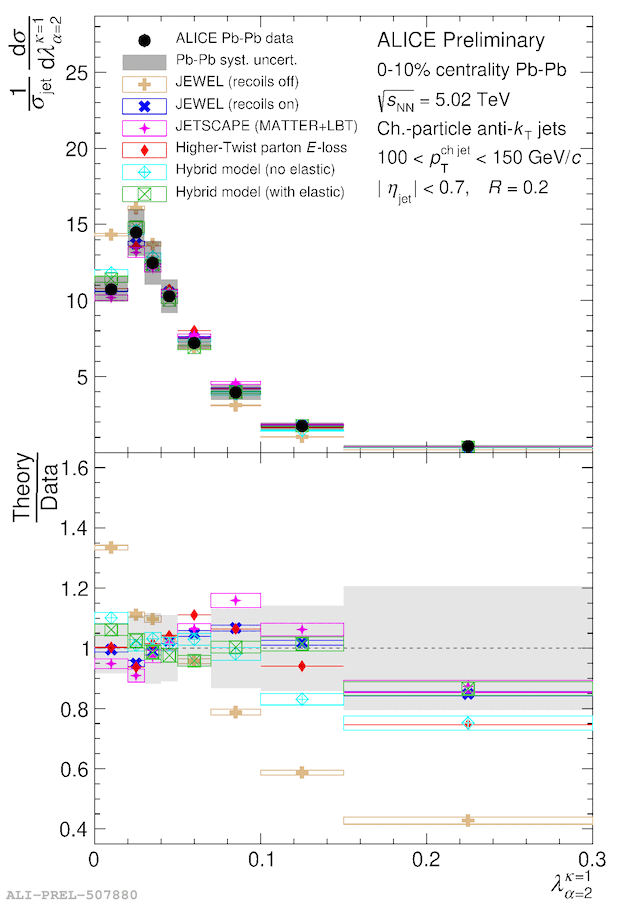
Ungroomed $\lambda_{\alpha=2}^{\kappa=1}$ for $R=0.2$ charged-particle jets in $100 < p_\text{T}^\text{ch jet} < 150$ GeV/$c$ in Pb-Pb collisions at $\sqrt{s_\text{NN}}=5.02$ TeV as compared to various models. On the top panel, the black data points and associated vertical error bars correspond to the ALICE measurement and its statistical uncertainties, with the grey boxes corresponding to systematic uncertainties. Also on the top panel, each model is presented with a box corresponding to the purely statistical uncertainties of the model calculation. On the bottom panel, the ratio of each model to ALICE data is presented. The total uncertainties on the model calculations are shown as bands around the points for each model. The grey bands around unity correspond to the combined statistical and systematic uncertainties on the measured data, added in quadrature.
Two predictions using the JEWEL event generator [1] are shown, which is based on a modified version of PYTHIA6. Events are generated with formation time $t_i = 0.4$ fm and initial temperature $T_i = 590$ MeV. In the "recoils off" case, recoiling medium partons are discarded from the event. In the "recoils on" case, medium partons are allowed to hadronize together with the jet, and recoil effects are subtracted by clustering the jets using the negative energy recombination scheme in which the four momenta of "event particles" are added together in the recombination step, and the four momenta of "thermal particles" is subtracted. The Higher-Twist parton energy loss approach to jet quenching [2] is shown, using POWHEG [3] with PYTHIA [4] matching at NLO as a baseline; a prediction using JETSCAPE [5] is given, with an in-medium parton shower described by the MATTER [6] (high-virtuality regime) and LBT [7] (low-virtuality regime) models; finally, predictions using the Hybrid model [8] both with and without elastic Molière scattering [9] are also given.
[1] Eur. Phys. J. C 74 (2) (2014) 2762, arXiv:1311.0048 [hep-ph]
[2] Chin. Phys. C45 (2021) no. 2, 024102, arXiv:2005.01093 [hep-ph]
[3] Nucl. Phys. Proc. Suppl. 205-206:36-41 (2010), arXiv:1007.3893 [hep-ph]
[4] Comput. Phys. Commun. 191 (Jun, 2015) 159–177, arXiv:1410.3012 [hep-ph]
[5] arXiv:1903.07706 [nucl-th]
[6] Phys. Rev. C 88 (2013) 014909, arXiv:1301.5323 [nucl-th]
[7] Phys. Rev. C 91 (2015) 054908, arXiv:1503.03313 [nucl-th]
[8] arXiv:1405.3864 [hep-ph]
[9] JHEP 01 (2019) 172, arXiv:1808.03250 [hep-ph]
